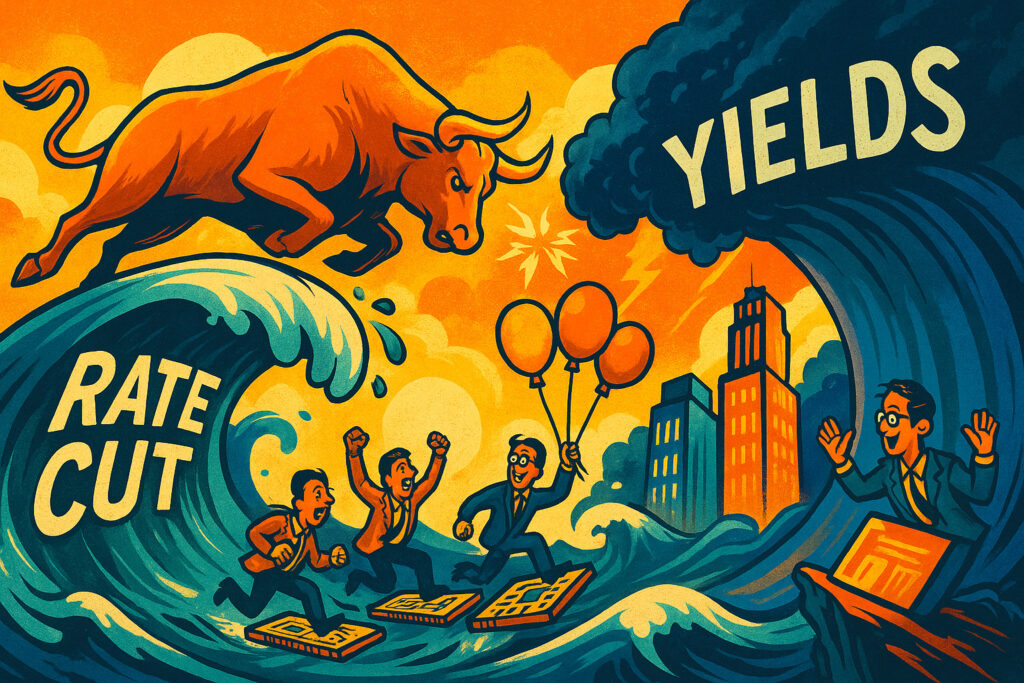Introduction
On 18 September 2025, markets extended their post–Fed cut momentum even as bond yields and currency markets rattled investor nerves. The U.S. Federal Reserve’s 25-basis-point rate cut of the prior day continued to echo through every asset class. Equities marched onward: the S&P 500, Dow, and Nasdaq all notched record-high closes, led especially by technology and AI names. Intel soared on news of a strategic partnership with Nvidia, igniting renewed chip-sector confidence. But behind the rally, bond yields surged, reminding markets that policy easing and inflation risk remain at odds.
The day captured the push–pull of September: euphoria backed by easing, tempered by the structural tension between yields, inflation, and central bank credibility.
Body
Equity Markets Hit New Highs
Wall Street’s momentum extended through 18 September. The S&P 500 climbed roughly 0.5% to a record close, the Nasdaq surged 0.9%, and the Dow advanced 0.3%. The Russell 2000 small-cap index also broke out, reaching its own record high. Broad participation across sectors signaled that today’s strength was not limited to tech alone.
Intel led the charge: its stock jumped over 20% after news that Nvidia would invest in producing joint AI and chip products. The collaboration revived optimism in the broader semiconductor space. Many brokers upgraded chip and infrastructure names in response, fueling further buying.
The expansion of gains into industrials, materials, and financials underlined market belief in a durable post-cut rally—investors appeared confident the easing cycle would power the next leg.
Bond Yields Jump Amid Rate Cut Reaction
Paradoxically, the Fed’s cut triggered a fresh surge in bond yields. The 10-year Treasury yield climbed as markets parsed the Fed’s messaging about future pacing and inflation risk. Investors appeared to interpret the dovish cut as conditional rather than open-ended, sparking repricing in credit-sensitive sectors.
Credit spreads remained tight, but the surge in benchmark yields weighed on yield curves and tested equity valuations. The bond market move signaled that the relief rally in rates was fragile—market participants were quick to remind themselves that easing is not the same as abandonment of vigilance.
Inflation & Producer Prices: The Balancing Act
While no new CPI release came that day, recent inflation data continued to influence sentiment. August CPI came in at 2.9% YoY, with core inflation near 3.1%, reaffirming that underlying price pressures are still sticky. Producer prices fell 0.1% month-over-month, suggesting some relief at the input stage, but the lag time to consumer prices remains uncertain.
Investors now eyes fixed on whether PPI softening will feed into CPI moderation in coming months—or if inflation surprises will again test the Fed’s resolve. The divergence between input and consumer inflation remains central to the narrative.
Consumer and Sentiment Signals Remain Weak
Consumer confidence continues to lag behind market optimism. University of Michigan’s sentiment survey placed consumer mood in early September in the mid-50s, with inflation expectations rising to ~3.9%. Households cited tariffs, wage pressure, and cost of living as persistent concerns.
This disconnect—record stock indexes paired with declining household sentiment—deepens the friction in the market’s current trajectory. If consumer demand deteriorates further, corporate revenue growth could come under stress even with easing policy.
Commodities: Gold Softens, Oil Mixed
Gold initially held near recent records but saw modest retreat on the day as higher yields undercut its safe-haven appeal. Still, gold remains a core hedge for many portfolios, especially in a world of policy uncertainty.
Oil was more volatile. Supply signals from OPEC+ and global demand forecasts created a tug of war between upward pressure and consumption concerns. Prices drifted moderately, with energy names underperforming broader indices.
As commodity markets digest both easing hopes and supply dynamics, oil and metals will remain a key pressure gauge for inflation expectations.
Currency Markets: Dollar Strength Returns
The U.S. dollar index recovered strength, bouncing back in response to higher Treasury yields and a more hawkish tone implicit in the Fed’s communications. The euro and other major currencies weakened moderately, while the yen slipped further amid domestic risk and global dollar strength.
For emerging markets, currency pressure intensified. Exporters tied to commodities fared marginally better, but many import-heavy nations saw capital outflow strains. The dollar’s rebound added to stress for countries with external debt exposure.
Sector Rotation: Tech Leads but Defensives Flex
Technology and semiconductor names remained the stars of the session, riding both the Intel news and lingering AI optimism. Infrastructure and cloud plays also participated, but sectors like real estate, utilities and consumer staples lagged.
Financials and industrials showed relative strength—some traders betting that easing will reignite credit growth and investment. Health care names remained mixed, balancing defensive appeal against cost pressures.
Valuation metrics showed tension: many growth names traded near rich multiples, suggesting risk of rotation if yields continue upward.
Conclusion
18 September 2025 stands out as a day of paradox: equities celebrated the Fed’s pivot with record highs, yet bond yields surged, dollar strength returned, and gold retreated. The cut was welcomed—but markets immediately priced in its limits.
This day is a snapshot of September’s dual narrative: hope of easing versus the gravity of yields and inflation. The rally endures, but it now does so under more scrutiny.
Key Questions Ahead
- Will the Fed double down with further cuts later this year or adopt a cautious pace?
- Can equity valuations hold if yields push higher, especially in rate-sensitive sectors?
- How will consumer sentiment and economic data align with the market’s optimism?
- Will inflation surprises—positive or negative—recalibrate the easing narrative?
18 September may come to be seen not just as a record high but a turning point: a moment when markets demanded clarity amid celebration.
